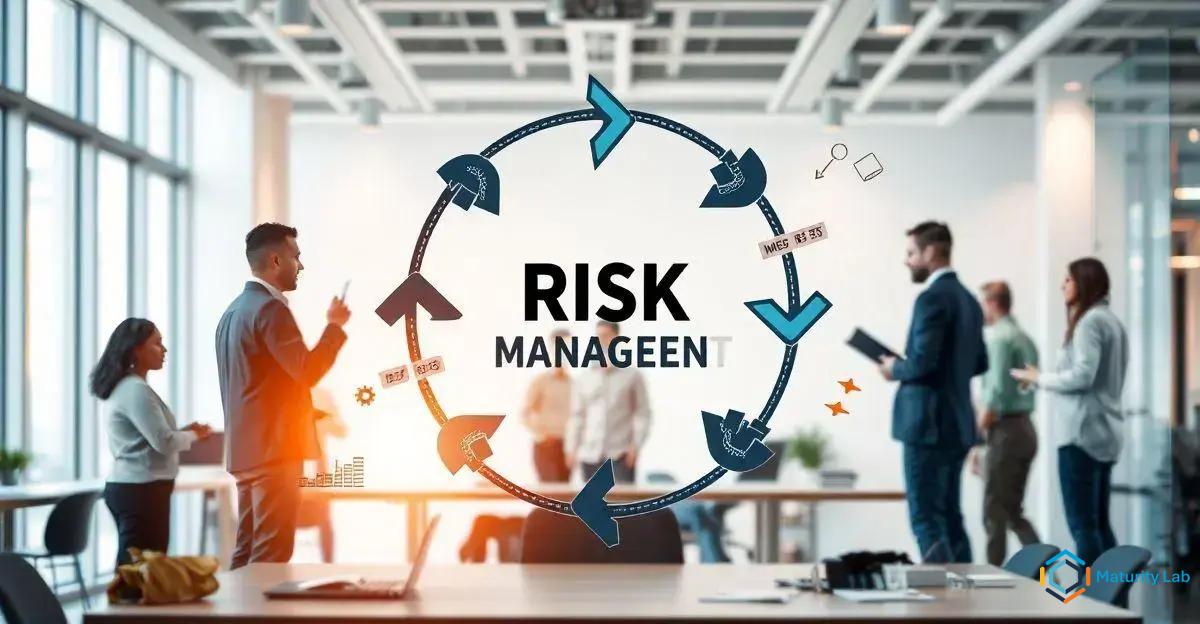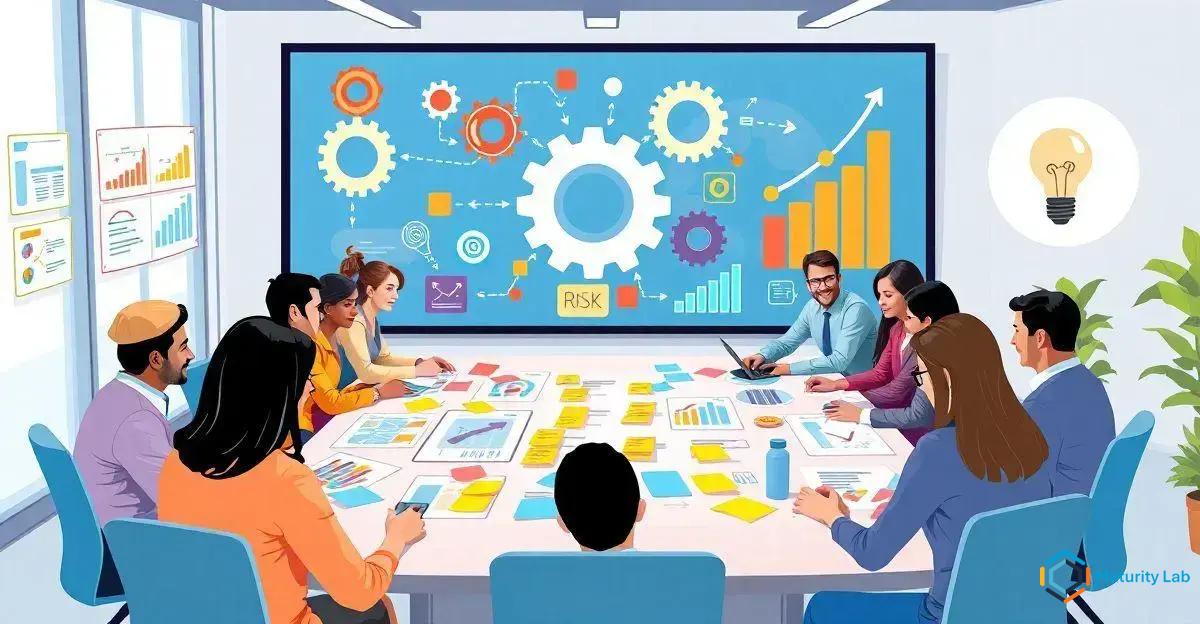The Risk Management Maturity Model (RMMM) is a framework that enhances an organization’s risk management capabilities by assessing key dimensions such as risk identification, assessment, mitigation, and monitoring. It promotes continuous improvement through comprehensive assessments, targeted action plans, leadership commitment, effective communication, and ongoing monitoring, ultimately ensuring organizational resilience and long-term success by aligning risk management with business objectives and leveraging technology.
In today’s dynamic business environment, understanding and managing risks effectively is crucial for sustained success. The Risk Management Maturity Model (RMMM) provides a structured approach to enhance risk management and drive continuous improvement. By leveraging RMMM, organizations can systematically identify, assess, and mitigate risks, ensuring resilience and adaptability. This article delves into the significance of RMMM, practical steps for its implementation, and how it fosters a culture of continuous improvement.
Understanding RMMM and Its Importance

The Risk Management Maturity Model (RMMM) is a comprehensive framework designed to evaluate and enhance an organization’s risk management capabilities.
By systematically assessing various aspects of risk management, RMMM helps organizations identify areas of strength and opportunities for improvement.
This model is particularly valuable in today’s volatile business landscape, where the ability to manage risks effectively can mean the difference between success and failure.
RMMM is structured around several key dimensions, including risk identification, risk assessment, risk mitigation, and risk monitoring.
Each dimension is further divided into specific criteria that organizations must meet to achieve higher maturity levels.
For instance, in the risk identification dimension, an organization might be evaluated on its ability to recognize emerging risks, its use of advanced risk identification tools, and its integration of risk identification processes into strategic planning.
One of the primary benefits of RMMM is its ability to provide a clear roadmap for continuous improvement.
By identifying specific areas where an organization falls short, RMMM enables targeted interventions that can enhance overall risk management capabilities.
This, in turn, leads to greater organizational resilience and a more proactive approach to managing uncertainties.
Moreover, RMMM fosters a culture of continuous improvement by encouraging organizations to regularly review and update their risk management practices.
This iterative process ensures that risk management remains a dynamic and integral part of the organization’s operations, rather than a static, one-time effort.
As a result, organizations that adopt RMMM are better equipped to adapt to changing circumstances and emerging threats.
In conclusion, understanding RMMM and its importance is essential for any organization seeking to enhance its risk management capabilities.
By providing a structured framework for assessing and improving risk management practices, RMMM helps organizations build resilience, drive continuous improvement, and ultimately achieve sustained success in a complex and uncertain world.
Implementing RMMM in Your Organization

Implementing the Risk Management Maturity Model (RMMM) in your organization requires a strategic and methodical approach. The process begins with a thorough assessment of your current risk management practices, followed by the development of a tailored action plan to address identified gaps and enhance overall maturity.
The first step in implementing RMMM is to conduct a comprehensive risk management assessment. This involves evaluating your organization’s existing risk management processes against the criteria outlined in the RMMM framework. Key areas to assess include risk identification, risk assessment, risk mitigation, and risk monitoring. Engaging stakeholders from various departments is crucial during this phase to ensure a holistic understanding of the organization’s risk landscape.
Once the assessment is complete, the next step is to develop an action plan. This plan should outline specific initiatives aimed at addressing the gaps identified during the assessment. For example, if the assessment reveals weaknesses in risk identification, the action plan might include initiatives such as implementing advanced risk identification tools, conducting regular risk workshops, and integrating risk identification into strategic planning processes. It is essential to prioritize these initiatives based on their potential impact and feasibility.
Leadership and Commitment
Effective implementation of RMMM also requires strong leadership and commitment from top management. Leaders must champion the importance of risk management and allocate the necessary resources to support the implementation efforts. This includes providing training and development opportunities for employees to enhance their risk management skills and knowledge.
Communication is another critical component of successful RMMM implementation. Regularly updating stakeholders on the progress of the implementation efforts helps maintain momentum and ensures alignment with organizational goals. Additionally, fostering a culture of continuous improvement and encouraging feedback from employees can lead to more effective and sustainable risk management practices.
Finally, it is important to establish mechanisms for monitoring and reviewing the effectiveness of the implemented initiatives. This involves setting up key performance indicators (KPIs) to track progress and conducting periodic reviews to assess the impact of the changes. By continuously monitoring and refining your risk management practices, your organization can achieve higher levels of maturity and resilience.
In summary, implementing RMMM in your organization involves a systematic approach that includes assessment, action planning, leadership commitment, effective communication, and continuous monitoring. By following these steps, your organization can enhance its risk management capabilities and drive continuous improvement.
Continuous Improvement through Effective Risk Management

Continuous improvement through effective risk management is a cornerstone of organizational resilience and long-term success. By integrating the principles of the Risk Management Maturity Model (RMMM) into daily operations, organizations can create a proactive culture that not only addresses current risks but also anticipates future challenges.
A key aspect of continuous improvement in risk management is the establishment of a feedback loop. This involves regularly collecting and analyzing data on risk management performance, identifying areas for enhancement, and implementing necessary changes. For instance, if an organization identifies recurring issues in its risk assessment processes, it can refine its methodologies, adopt new tools, or provide additional training to its staff. This iterative process ensures that risk management practices evolve in response to both internal and external changes.
Alignment with Organizational Objectives
Another important element is the alignment of risk management with organizational objectives. Effective risk management should not be seen as a standalone function but as an integral part of strategic planning and decision-making. By aligning risk management initiatives with business goals, organizations can ensure that they are not only protecting their assets but also enabling growth and innovation. For example, a company looking to expand into new markets can use risk management insights to navigate regulatory challenges, assess market conditions, and mitigate potential operational risks.
Moreover, fostering a culture of continuous improvement requires active engagement from all levels of the organization. Leadership must set the tone by prioritizing risk management and encouraging a mindset of vigilance and adaptability. Employees, on the other hand, should be empowered to identify risks and suggest improvements. This can be achieved through regular training sessions, open communication channels, and recognition of proactive risk management behaviors.
Technology also plays a vital role in supporting continuous improvement in risk management. Advanced analytics, machine learning, and other digital tools can provide deeper insights into risk patterns and trends, enabling more informed decision-making. For instance, predictive analytics can help organizations anticipate potential disruptions and develop preemptive strategies to mitigate their impact.
Finally, continuous improvement in risk management involves benchmarking against industry standards and best practices. By comparing their risk management maturity with peers and industry leaders, organizations can identify gaps and adopt proven strategies to enhance their capabilities. This not only helps in achieving higher maturity levels but also in maintaining a competitive edge.
In conclusion, continuous improvement through effective risk management is essential for building a resilient and adaptive organization. By establishing a feedback loop, aligning risk management with organizational objectives, engaging all levels of the organization, leveraging technology, and benchmarking against best practices, organizations can create a robust risk management framework that drives sustained success.
In summary, the Risk Management Maturity Model (RMMM) serves as an invaluable tool for organizations striving to enhance their risk management capabilities and foster a culture of continuous improvement.
By understanding the core dimensions of RMMM and its importance, organizations can systematically assess their current practices and identify areas for enhancement.
Implementing RMMM involves a structured approach that includes a comprehensive assessment, development of a targeted action plan, strong leadership commitment, effective communication, and continuous monitoring.
Continuous Improvement
Furthermore, continuous improvement through effective risk management is crucial for building organizational resilience and achieving long-term success.
Establishing a feedback loop, aligning risk management with organizational objectives, engaging all levels of the organization, leveraging advanced technologies, and benchmarking against industry standards are essential components of this process.
By integrating these elements, organizations can not only manage current risks more effectively but also anticipate and mitigate future challenges.
Ultimately, adopting RMMM and committing to continuous improvement in risk management enables organizations to navigate the complexities of today’s business environment with greater confidence and agility.
This proactive approach not only safeguards the organization’s assets but also drives innovation and growth, ensuring sustained success in an ever-evolving landscape.
Frequently Asked Questions about RMMM, Risk Management, and Continuous Improvement
What is the Risk Management Maturity Model (RMMM)?
The Risk Management Maturity Model (RMMM) is a comprehensive framework designed to evaluate and enhance an organization’s risk management capabilities. It assesses various dimensions such as risk identification, risk assessment, risk mitigation, and risk monitoring.
Why is RMMM important for organizations?
RMMM is important because it provides a structured approach to identify areas of strength and opportunities for improvement in risk management. This helps organizations build resilience, drive continuous improvement, and achieve sustained success.
How can an organization implement RMMM?
Implementing RMMM involves conducting a comprehensive risk management assessment, developing a targeted action plan, securing leadership commitment, maintaining effective communication, and establishing mechanisms for continuous monitoring and review.
What role does leadership play in the implementation of RMMM?
Leadership plays a crucial role by championing the importance of risk management, allocating necessary resources, and fostering a culture of continuous improvement. Strong leadership commitment is essential for successful RMMM implementation.
How does continuous improvement enhance risk management?
Continuous improvement enhances risk management by establishing a feedback loop, aligning risk management with organizational objectives, engaging all levels of the organization, leveraging technology, and benchmarking against industry standards. This ensures that risk management practices evolve and adapt to changing circumstances.
What are the benefits of aligning risk management with organizational objectives?
Aligning risk management with organizational objectives ensures that risk management initiatives support business goals, enabling growth and innovation while protecting assets. This integrated approach leads to more informed decision-making and greater organizational resilience.

